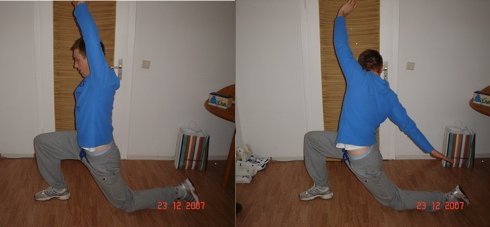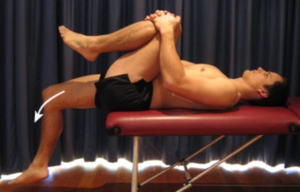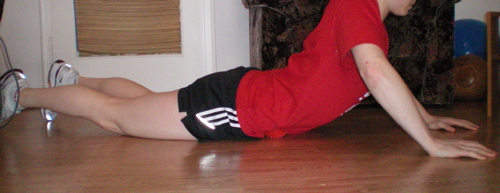We have spoken before about hip flexors and how important their optimal function to the body actually is. The Psoas in particular attaches up on your spine, which means if it is not functioning well, then it can greatly affect your back. Imagine the pressure of a rope, holding onto the middle of your back and pulling it constantly forward. Yep, it’s pretty painful. A lot of lower back problems are easily fixed by releasing your Psoas. This is only one problem that a malfunctioning hip flexor can cause, the reality is that this muscle plays a lot of functions in your body.
How To Loosen Hip Flexors?
There are three basic ways that you can do to loosen your hip flexors, and the reality is the best thing to do is do all of them. The three methods are:
- Stretching
- Soft Tissue Therapy
- Active Release
Let’s talk through these a little.
Stretching
This is a reasonably obvious one, but it is important to get the right stretches in. Your hip flexor is made largely up of a lot of fascia. Stretching is important, but you need to do it the right way, and it should be accompanied by other releasing methods. Ensure that you hold stretches for at least 30 seconds so you can start to release the fascia as well. You will actually feel your hip flexors releasing. Here you have an example of a stretch to do by yourself, and a stretch that you can do with a partner.
As you can see in this first stretch, you need to put your arms above your head to stretch out your body, stretch out the fascia. Reaching back behind starts to open up the hip flexors even more. Remember to hold this for at least 30 seconds.
This next stretch is one you can do in partners. Hold your knee whilst lying off a table, butt on the edge. Get the partner to push down onto the leg that is hanging off the table. Stretch it for 10 seconds, then get the person on the table to push back up whilst you resist them for 5 seconds. Stretch them again passively for another 10 seconds, and push for more range. Remember the hip flexor is a tough muscle, you need to stretch it hard. This is called PNF stretching and is a very useful technique for getting range of motion.
Soft Tissue Therapy
Here is an excerpt from the Tennis Ball Therapy article explaining how to do soft tissue work.
This is a tough one to actually get trigger points done with the tennis ball, however this kind of work will give it a good release. The Psoas is often tight from people sitting down at work all day and having it in a shortened position.
How To:
About 2 cm right from your belly button is the initial place you want to put the ball. Lay flat and gradually raise yourself up of the ground. The higher you go the more stretch and consequently more pressure you put through your Psoas. Repeat this with the ball in the same spot a few times, then move it up and down slightly. Test out each area of the Psoas and find where you are tightest. Not everyone will feel something from this exercise, if you are tight in the Psoas I find the best way to get nice and deep where you need is some hands on active release work or acupuncture. However this is a good, cheap and convenient start!
If you like the idea of healing your pain with a tennis ball, then your should check out my Tennis Ball Massage Guide. It will talk in more detail about how to attack the hip flexors (Psoas, Illiacus and Rec Fem), and give you step by step instructions on how to release your body with a foam roller and tennis ball.
Active Release
There is a phenomenon called reciprocal inhibition. Basically muscles work in pairs, and when one muscle in that pair is active and working, the other one will release and relax. Your glutes and your hip flexor experience this phenomenon. So what am I saying? Well, working your glutes will help to release your hip flexors, but even more so, working your glutes in exercises that stretch your hip flexors are even better. Lunges are a great exercise for this, but here is a picture of another great one. It’s called the bridge and it basically works your glutes and puts your hip flexor on stretch at the same time. Ensure that you feel your glutes working and contracting. Do it 10 to 15 times and 2 to 3 sets of it.

So here you have three methods to release your hip flexors, try them all and you will feel a difference. If you want to see a detailed program, check out this kindle book.



Darrin says
Perfect. I had some really tight hip flexors earlier this year, and sad to say I had not been doing any of the above. I should have known better. I had also added in deeper squats, thinking that would expand my flexibility (made the psoas tighter actually). That first stretch, plus a variation called the Atlas, really helped as did foam rolling (wasn’t ready for the tennis ball at that point – had to work up to that!). As usual, great article Lauren!
Alex says
Good article, thank you! I’m always looking for ways to loosen up my hip flexors. I have a question: when you say ” then get the person on the table to push back up whilst you resist them for 5 seconds” do you mean the other person will attempt to lift my leg up while I resist? The phrase “push back up” has me confused…
Lauren says
Wow, way to miss this. Sorry Alex. I will answer for future people with the same questions. No, assuming you are the one on the table being stretched, you will try to lift your leg up and the person stretching you will try to resist. Make that muscle work.
Kathy McKenna says
I had back surgery 1 year ago but prior to that I was bent forward up to 6 inches. My pcp Dr. did not believe in back surgery as he is a D.O. and put me off for 5 years. Finally I demanded that send me to a neurologist specializing in back surgery. My cousin is also a D.O. but recommended the surgeon as he fixed my cousin’s neck as he had a bulging disc and could not turn his head. Mine were in the L4-L5 area and L5-S1. I had surgery 1 year ago and still have back pain even though the removed 2 discs had new bone growth. My dr. said my hips were stuck in a flex position due to being bent forward 6″ for 5 years. What are the best exercises for me given that I have hardware in my back, 2 rods, 5 screws and a plastic cage around this? The surgeon said he was ordering a special back brace that goes to the thighs. I would love some advice. Kathy McKenna
Lauren says
Hi Kathy I sent you an email a few weeks ago in reply to this did you get it?
Deb says
I have had a systemic inflammatory disease that has affected my muscles and joints for the past 6 years. To complicate that, I’ve been told that I also have a Grade 1 tip of my L5 vertebrae and severe stenosis. My Drs. recommend spinal fusion to fix the tip, but I don’t believe its the cause of my mobility issues, so have elected to put it off until I am certain there is no alternative. One area that I believe is contributing to a large degree to my back spams is my continued inability to straighten up…I have a severe anterior pelvic tip. This seems to originate in my hip flexors, so like the above post, I am looking for gentle but effective exercises to help release my hip flexors and strengthen my abs, gluts and hamstrings, so that my lower back muscles are not doing the bulk of the work.